Origins
It was commissioned in 1832 by Jewish naval officer and New York real estate investor Uriah Phillips Levy, who was interested in Thomas Jefferson (eventually purchasing his home of Monticello in 1836 with the goal of historic preservation). [1] Uriah told a friend that he had the statue made in tribute of Jefferson's stance on religious liberty, which he credited for his ability to succeed in the United States government as a Jewish man. [1]
Levy visited the Paris studio of accomplished sculptor and École des Beaux Arts professor Pierre-Jean David d’Angers in 1832 and contracted the statue. [1] Marquis de Lafayette provided his portrait of Thomas Jefferson by Thomas Sully for a reference. [1] The statue was completed in clay in 1834 and was cast in bronze by Honoré Gonon and Sons. [1] A story said that when the statue was finished, Lafayette embraced it, saying "Mon ami, mon ami" ("My friend, my friend"). [2]
The statue shows Jefferson with a pen in one hand and a copy of the Declaration of Independence in the other. There are also two books and a laurel wreath between his feet. On February 6, 1834, Levy gave the painted plaster model of the statue to the City of New York. [1]
In March 1834, Levy offered the bronze statue to the Congress, and it was accepted in a letter by Senator Asher Robbins of Rhode Island, who was Chairman of the Joint Committee on the Library. [1] The Senate agreed to accept the statue, but in debate some House members questioned it for a variety of reasons, including if it was proper to have a statue of Jefferson before they installed one of George Washington. [1]
Movement
While the work was initially placed in the Capitol rotunda, it was removed at an uncertain time, possibly in order to be replaced by the statue of George Washington by Horatio Greenough. [1] In 1847, under authorization of President James K. Polk, it was moved to a pedestal on the north White House lawn. [1] In 1873, during the presidency of Ulysses S. Grant, it was replaced in the North Lawn by a fountain and was moved to the East Entrance of the White House. [1]
In 1874, Uriah Levy's brother lobbied Congress to have the statue returned to the Capitol. Damaged by its long exposure outside, it was cleaned and repaired. [1] It was first placed in the National Statuary Hall, yet it was finally returned to the Rotunda in 1900, where it still remains. [1]
New York City version
In 1834, when the Common Council accepted Levy's gift, they also gave him a gold snuff box and the Freedom of the City. [2] Before the statue was officially installed, it was displayed at 355 Broadway, with admission charged for viewing. According to press reports, the proceeds let Levy purchase and distribute 1,200 loaves of bread to be given to the poor. [3]
For around seven decades, the statue was said to sit in the Governor's Room of City Hall. [2] At some point, however, it was placed in a hall of the building's basement. [2] After lobbying by Jefferson Monroe Levy, the Art Commission voted on July 1, 1919 to return the statue to the Governor's Room. [2]
In 1995, as Deputy Mayor John S. Dyson was planning to restore City Hall, art scholar Leslie Freudenheim advocated it be moved from the side of the council chambers, where it had been placed at some point, to a more prominent location "at the juncture of City Hall's two magnificent, curvilinear staircases." [3]
In 2011, when the Council returned after a year and a half of renovations, councilmember Letitia James noted that the statue had been cleaned. [4]
Removal
Calling Jefferson "America's most noted slaveholder," on June 18, 2020, councilmembers Corey Johnson, Deborah Rose, Inez Barron, Adrienne Adams, Daneek Miller wrote a letter to Mayor Bill de Blasio asking him to support the statue's removal. [5] On June 19, 2020, the Mayor stated that the review of this statue would be an issue explored by a "Commission on Racial Justice and Reconciliation" headed by First Lady Chirlane McCray. [6]
The New York City Public Design Commission voted unanimously to remove the statue in October 2021. [7] The statue was removed in November 2021. [8]

The United States Capitol, often called The Capitol or the Capitol Building, is the meeting place of the United States Congress and the seat of the legislative branch of the U.S. federal government. It is located on Capitol Hill at the eastern end of the National Mall in Washington, D.C. Though no longer at the geographic center of the federal district, the Capitol forms the origin point for the district's street-numbering system and the district's four quadrants.

The Statue of Freedom, also known as Armed Freedom or simply Freedom, is a bronze statue designed by Thomas Crawford (1814–1857) that, since 1863, has crowned the dome of the U.S. Capitol building in Washington, D.C. Originally named Freedom Triumphant in War and Peace, a U.S. government publication now states that the statue "is officially known as the Statue of Freedom." The statue depicts a female figure bearing a military helmet and holding a sheathed sword in her right hand and a laurel wreath and shield in her left.
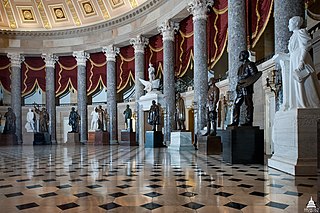
The National Statuary Hall is a chamber in the United States Capitol devoted to sculptures of prominent Americans. The hall, also known as the Old Hall of the House, is a large, two-story, semicircular room with a second story gallery along the curved perimeter. It is located immediately south of the Rotunda. The meeting place of the U.S. House of Representatives for nearly 50 years (1807–1857), after a few years of disuse in 1864 it was repurposed as a statuary hall; this is when the National Statuary Hall Collection was established. By 1933 the collection had outgrown this single room, and a number of statues are placed elsewhere within the Capitol.

The National Statuary Hall Collection in the United States Capitol is composed of statues donated by individual states to honor persons notable in their history. Limited to two statues per state, the collection was originally set up in the old Hall of the House of Representatives, which was then renamed National Statuary Hall. The expanding collection has since been spread throughout the Capitol and its Visitor's Center.
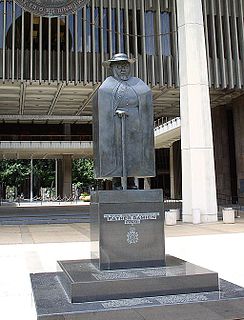
The Father Damien Statue, also called the Saint Damien of Molokaʻi Statue, is the centerpiece of the entrance to the Hawaiʻi State Capitol and the Hawaiʻi State Legislature in Honolulu, Hawaiʻi. A second bronze cast is displayed in the National Statuary Hall Collection in the United States Capitol, along with the Kamehameha Statue. The landmark memorializes the famous Hawaiʻi Catholic Church priest from Belgium who sacrificed his life for the lepers of the island of Molokaʻi. Father Damien is considered one of the preeminent heroes of Hawaiʻi, and was canonized by Pope Benedict XVI on October 11, 2009. Cast in bronze, the statue depicts Father Damien in his later years after being diagnosed with the disease of those he attended. Much attention was given to the recreation of the disfiguring scars on the priest's face and his arm hanging from a sling.

Karl Theodore Francis Bitter was an Austrian-born American sculptor best known for his architectural sculpture, memorials and residential work.
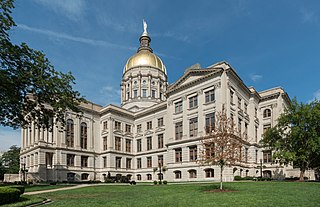
The Georgia State Capitol is an architecturally and historically significant building in Atlanta, Georgia, United States. The building has been named a National Historic Landmark which is listed on the National Register of Historic Places. As the primary office building of Georgia's government, the capitol houses the offices of the governor, lieutenant governor, and secretary of state on the second floor, chambers in which the General Assembly, consisting of the Georgia State Senate and Georgia House of Representatives, meets annually from January to April. The fourth floor houses visitors' galleries overlooking the legislative chambers and a museum located near the rotunda in which a statue of Miss Freedom caps the dome.

The Kentucky State Capitol is located in Frankfort and is the house of the three branches of the state government of the Commonwealth of Kentucky. The building is listed on the National Register of Historic Places.

Jefferson Monroe Levy was a three-term U.S. Congressman from New York, a leader of the New York Democratic Party, and a renowned real estate and stock speculator.

Uriah Phillips Levy was a naval officer, real estate investor, and philanthropist. He was a veteran of the War of 1812 and the first Jewish Commodore of the United States Navy. He was instrumental in helping to end the Navy's practice of flogging, and during his half-century-long service prevailed against the antisemitism he faced among some of his fellow naval officers.

The United States Capitol rotunda is the tall central rotunda of the United States Capitol in Washington, D.C. It has been described as the Capitol's "symbolic and physical heart". Built between 1818 and 1824, the rotunda is located below the Capitol dome, which was built between 1857 and 1866.
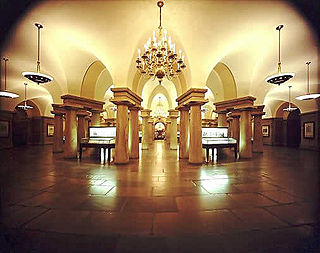
The United States Capitol crypt is the large circular room filled with forty neoclassical Doric columns directly beneath the United States Capitol rotunda. It was built originally to support the rotunda as well as offer an entrance to Washington's Tomb. It currently serves as a museum and a repository for thirteen statues of the National Statuary Hall Collection.

George Washington is a statue by French sculptor Jean-Antoine Houdon from the late 18th century. Based on a life mask and other measurements of George Washington taken by Houdon, it is considered one of the most accurate depictions of the subject. The original sculpture is located in the rotunda of the Virginia State Capitol in Richmond, Virginia, and has been copied extensively.

Chirlane Irene McCray is an American writer, editor, and activist. She is married to New York City Mayor Bill de Blasio and has been described as de Blasio's "closest advisor." She chairs the Mayor's Fund to Advance New York City and leads ThriveNYC. She has also published poetry and worked in politics as a speechwriter.

George Washington is a marble bust portrait of George Washington, done in the style of a Roman emperor, by the Italian sculptor Giuseppe Ceracchi. It was created as part of a campaign by Ceracchi to build a larger monument to Washington. The bust was thought by many to be one of the most lifelike. It was later used as a model of Washington for works by other sculptors and engravers.
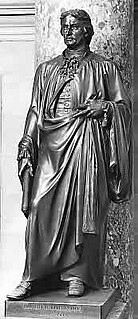
Robert R. Livingston is an 1875 bronze sculpture of Robert R. Livingston, one of the Founding Fathers of the United States, executed by the New York born sculptor Erastus Dow Palmer. The state is installed in the United States Capitol, in Washington, D.C., as part of the National Statuary Hall Collection. It is one of two statues donated by the state of New York.

George Washington was a life-size marble statue of George Washington, done in the style of a Roman general, by the Italian Neoclassical sculptor Antonio Canova. Commissioned by the State of North Carolina in 1815, it was completed in 1820 and installed in the rotunda of the North Carolina State House on December 24, 1821. The building and the statue were destroyed by fire on June 21, 1831. This work was the only one created by Canova for the United States.

The Statue of Jefferson Davis was unveiled in the Kentucky State Capitol Rotunda, in Frankfort, Kentucky on December 10, 1936. It depicts Jefferson Davis, president of the Confederate States of America. It was erected under the auspices of the United Daughters of the Confederacy. It remained there until June 13, 2020. The Historic Properties Advisory Commission voted to move the statue out of the Rotunda to the Jefferson Davis State Historic Site near Fairview, Kentucky.

Horatio Stone, was an American sculptor, physician and writer. He is best remembered for his three statues in the U.S. Capitol.



















